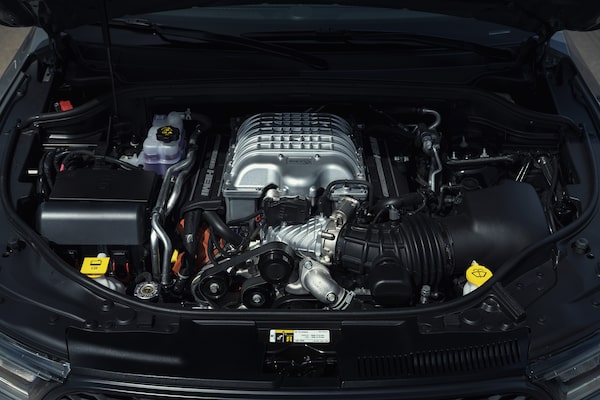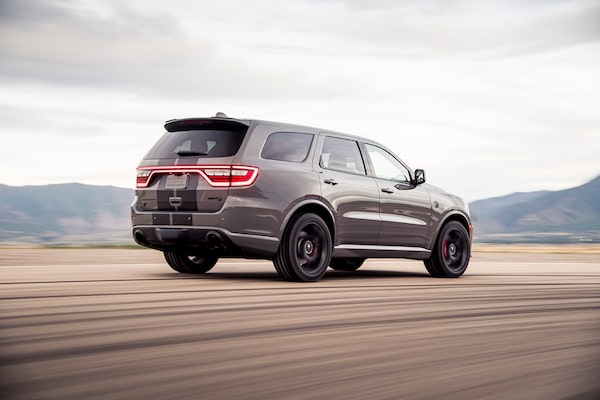
The 2021 Dodge Durango SRT Hellcat.FCA US LLC/Courtesy of manufacturer
The price of gas is down, and Dodge wants to make the most of it with three new Hellcat performance vehicles, including a three-row Durango Hellcat SUV.
These are “for the real crazies, who think enough is never enough,” says Tim Kuniskis, FCA’s head of passenger cars for North America. “Dodge now offers three 700-horsepower-plus muscle cars. This really is the golden age of muscle.”
The most powerful is the new Challenger Hellcat Super Stock, which creates 807 hp and, Dodge claims, will cover a quarter-mile in 10.5 seconds at 211 km/h. It uses the existing 6.2-litre V8 Redeye engine but has improved suspension to help it dig in and shave 0.4 seconds from the Redeye’s quarter-mile time.
The Super Stock uses the current widebody chassis setup, but now has 3.09 final-drive gearing on its limited-slip differential, with 18x11-inch wheels and 315-width tires for extra traction. “As cool as burnouts at 50 mph are,” says Kuniskis, “spinning isn’t winning.”
In Track mode, the Super Stock removes all rebound damping from the front suspension while maintaining all steering control, and it activates a revised, full-control suspension adjustment at the rear.
“The front end lifts, creating weight transfer,” says Darryl Smith, Dodge’s director of performance vehicles. “The rear end holds all that weight transfer, those great big drag radials wind up, and you are pushed firmly to the back of your seat in the most aggressive launch in the muscle car business. And that feeling never gets old.”
The Challenger SRT Superstock will be built in Brampton, Ont., and will be available this fall. No price is yet announced, but the current Challenger Hellcat Redeye Widebody has an MSRP of $93,666 – three times the cost of the most basic Challenger SXT, which lists for $32,507.
The four-door Dodge Charger Hellcat is also pumped up for 2021 with a Redeye edition, which will boost the sedan’s output from 717 hp and 650 lb.-ft. of torque to 797 hp. Dodge says this will make it the most powerful and fastest sedan in the world, with a quarter-mile time of 10.6 seconds at 208 km/h. Its top speed is claimed to be 327 km/h.
At full throttle, says Dodge in a press release, “the Dodge Charger SRT Hellcat Redeye consumes 5.4 litres/minute of fuel – enough to drain the fuel tank in just under 11 minutes, yet is still rated at 10.7 L/100 km when driven in normal highway conditions.”
The Charger Redeye will be available early next year, and again, no price is yet released. Current Charger Hellcats have an MSRP of $77,699.

The SRT Black Package adds these 20x10-inch wheels.Courtesy of manufacturer
Perhaps the rarest of the three new Hellcats, however, will be the Dodge Durango Hellcat SUV. It will only be built for the first six months of 2021, and it will not be continued for 2022 – emissions controls that come into effect for that model year will be too prohibitive. Dodge expects to make fewer than 2,000 of them.
The Durango Hellcat will be powered by a 6.2-litre V8 engine and will generate 710 hp and 645 lbs.-ft. of torque. Dodge says it’s been timed at 11.5 seconds over a quarter-mile track and can cover zero-to-100 km/h in about 3.5 seconds. It also has a towing capability of 8,700 lbs. (3,946 kg), the same as the regular 6.4-litre Hemi V8.

The Durango SRT Hellcat will be powered by a supercharged 6.2-litre V8.FCA US LLC/Courtesy of manufacturer
It has a much stiffer and more aerodynamic body, to handle the challenges of driving such a large vehicle at speed. A small rear spoiler adds 140 pounds of downforce at the SUV’s top speed of 290 km/h, while an aggressive front “chin-splitter” beneath the grille reduces front-end lift by preventing air from going under the vehicle.
“When you combine the spoiler with the chin-splitter, you get a 30-per-cent improvement in aerodynamic balance,” says Jamie Standring, Dodge’s chief engineer for performance SUVs. Brakes and suspension are also upgraded, with a 5-per-cent improvement in its roll gradient. “That means the car feels more like it’s on rails,” says Standring.
The Durango’s chief designer is more to-the-point in his description. “From a designer’s perspective, it just looks bad-ass and makes the car look really planted on the road,” says Brian Nielander.

Design tweaks are intended to improve aerodynamics and give the Hellcat a more aggressive stance.Courtesy of manufacturer
Inside the Durango Hellcat, the controls are focused more toward the driver, and connectivity is handled through FCA’s latest-generation UConnect5 system, which is up to five times faster than before. Engineers took the system home on their iPads and tablets, and their families showed them what passengers really wanted from its controls and displays, other than just acceleration and top speed.
There is no price yet announced for the Durango SRT Hellcat. The current top-end Durango SRT has an MSRP of $68,611, so the Hellcat version can be expected to start at about $85,000.
Shopping for a new car? Check out the Globe Drive Build and Price Tool to see the latest discounts, rebates and rates on new cars, trucks and SUVs. Click here to get your price.
Stay on top of all our Drive stories. We have a Drive newsletter covering car reviews, innovative new cars and the ups and downs of everyday driving. Sign up for the weekly Drive newsletter, delivered to your inbox for free. Follow us on Instagram, @globedrive.
 Mark Richardson
Mark Richardson